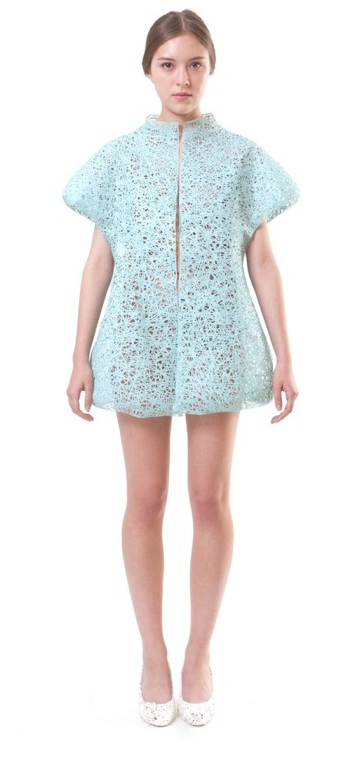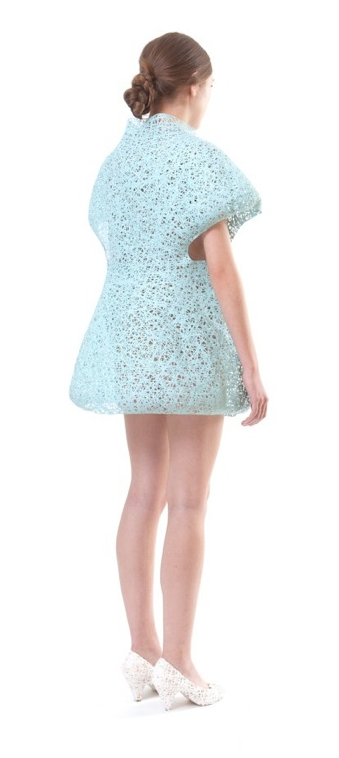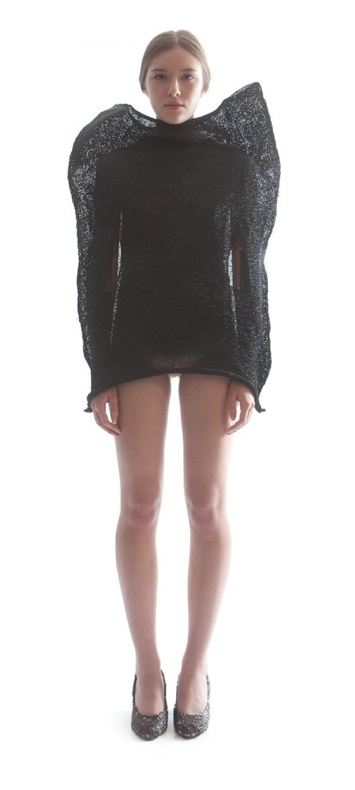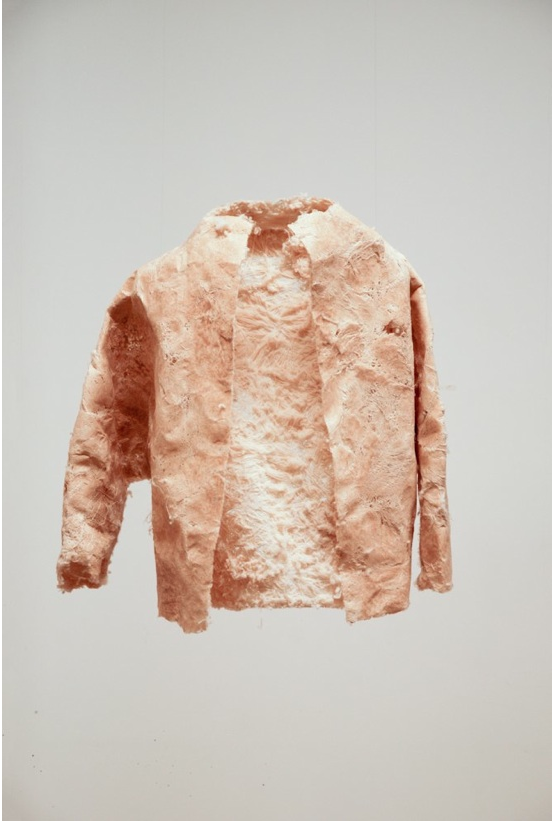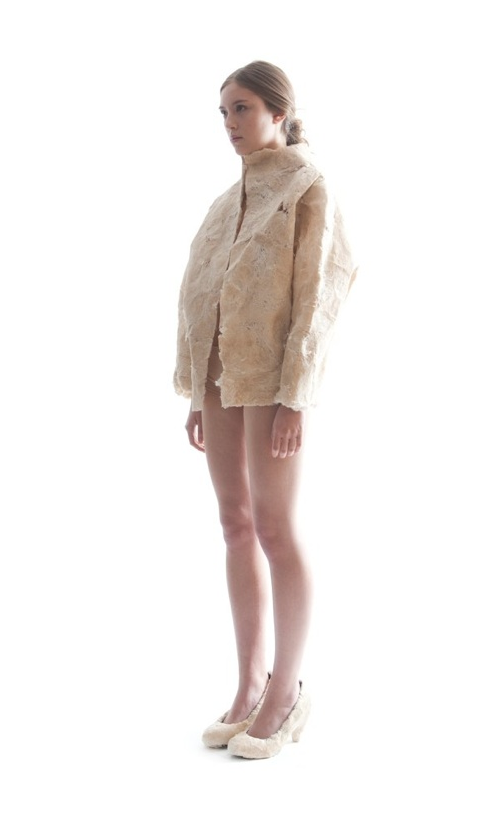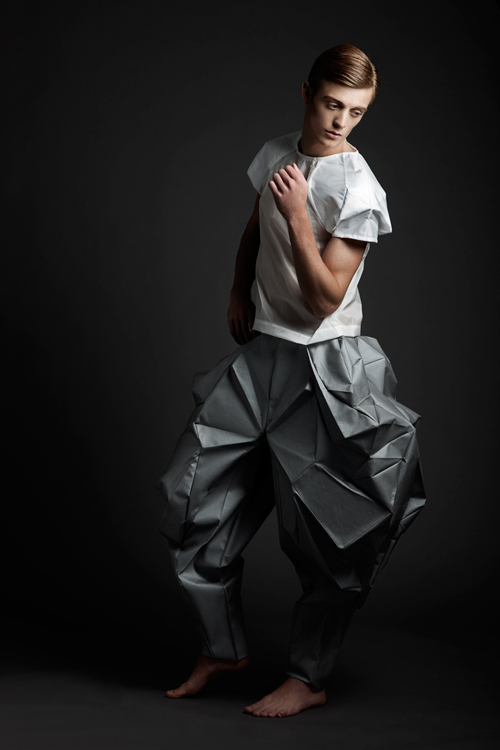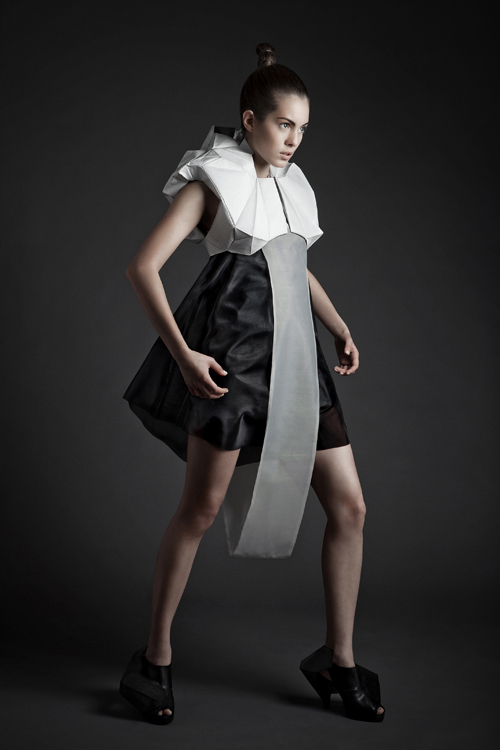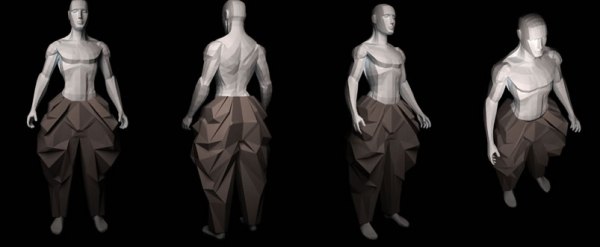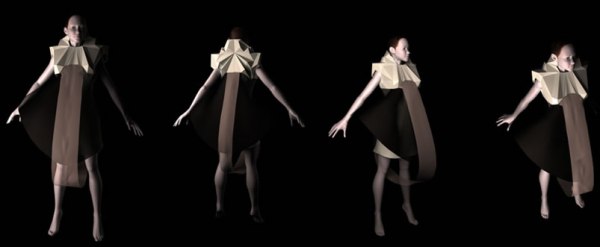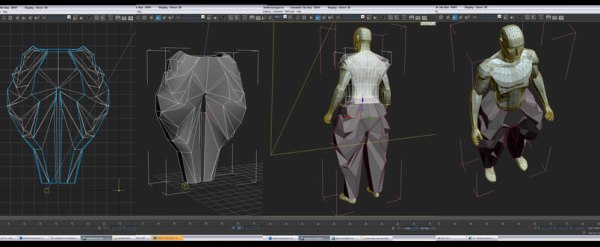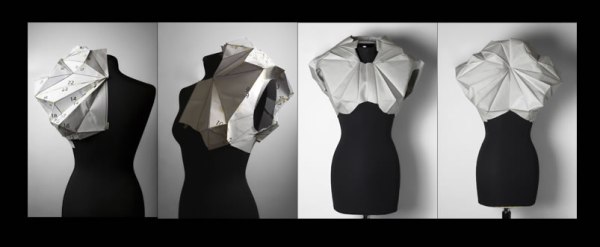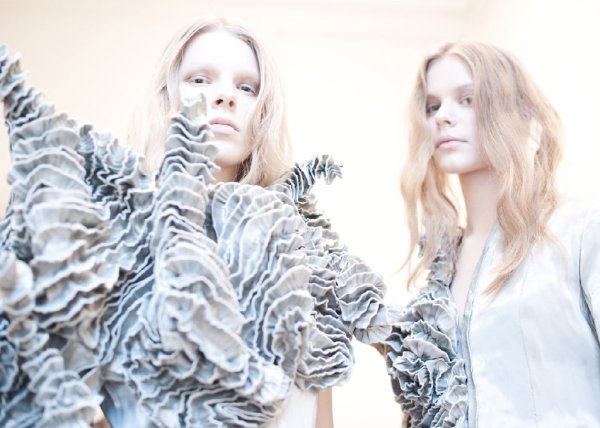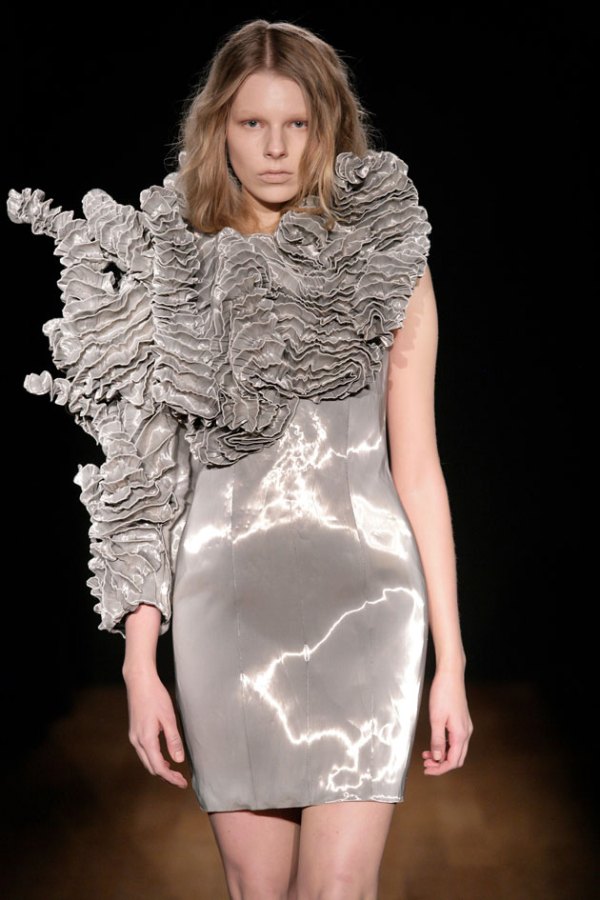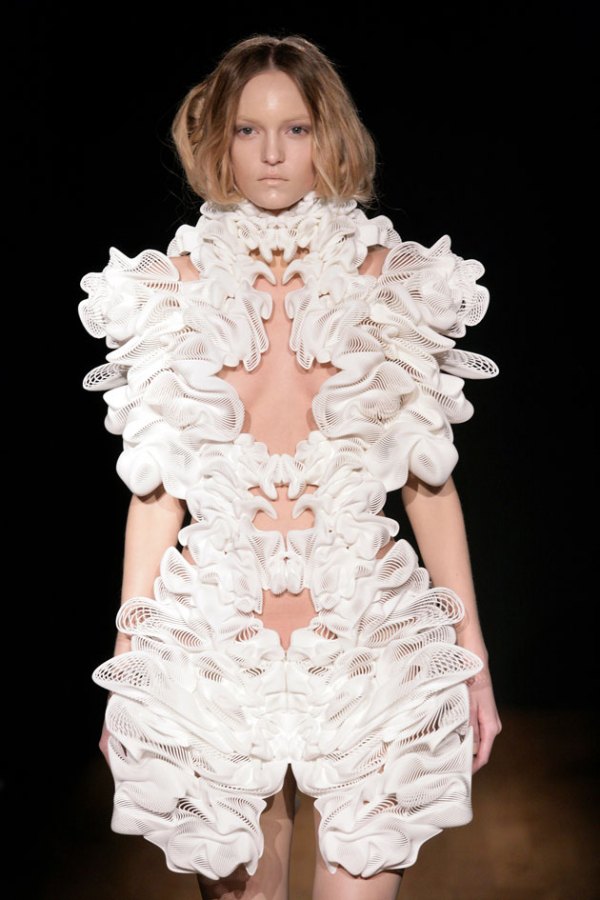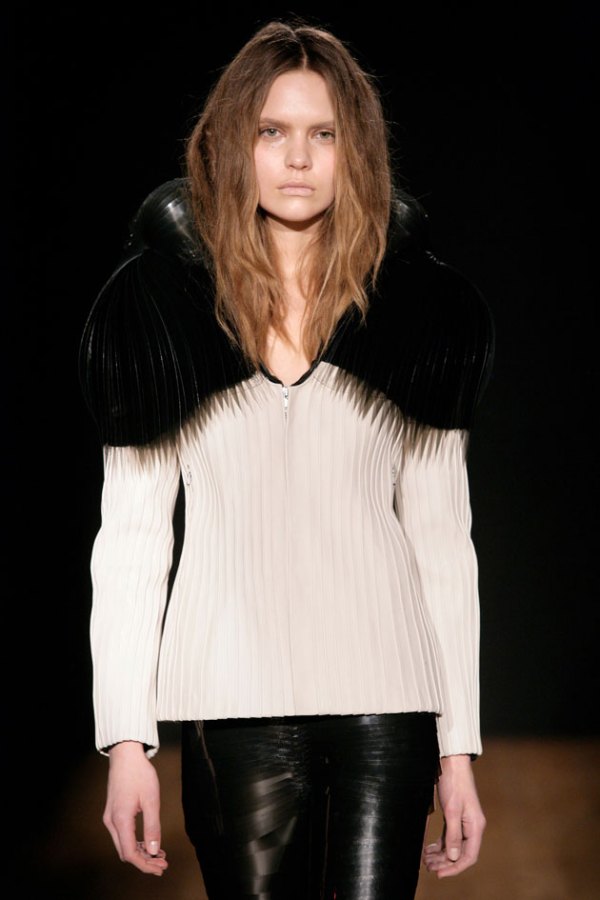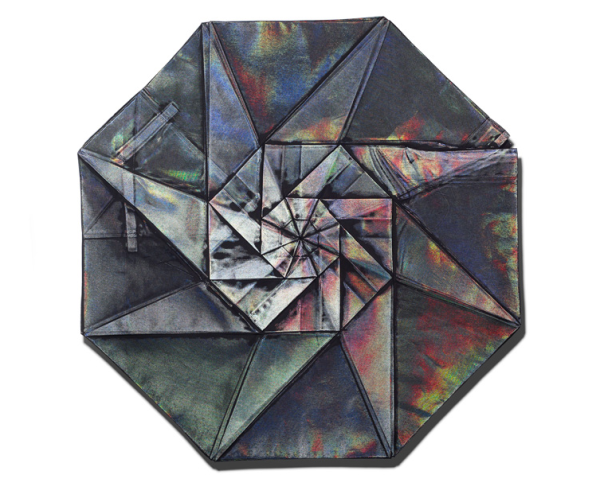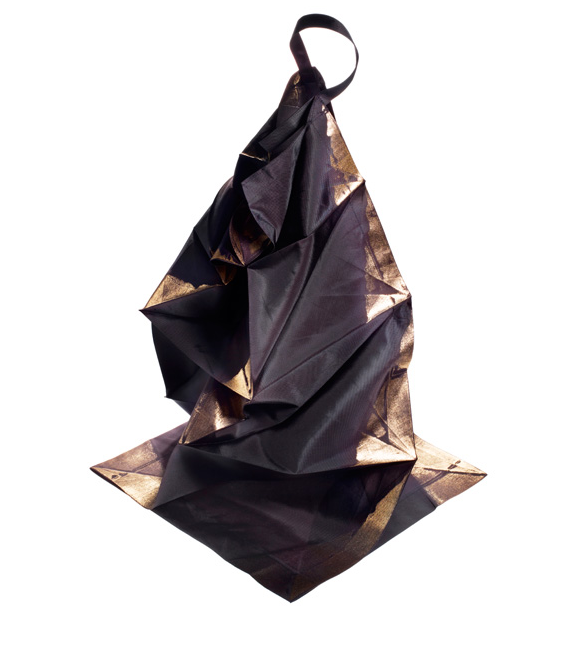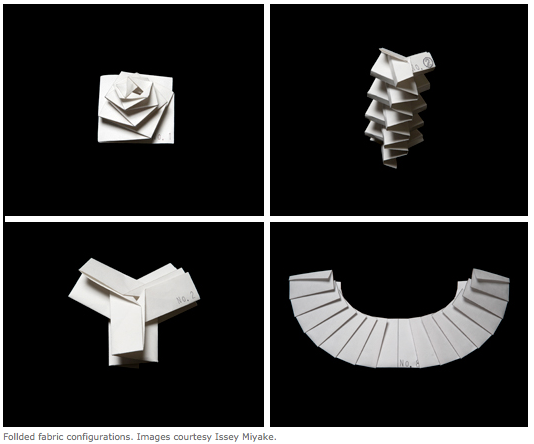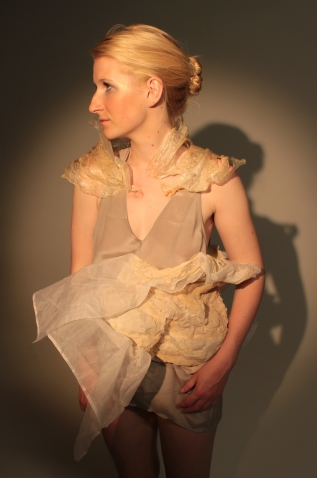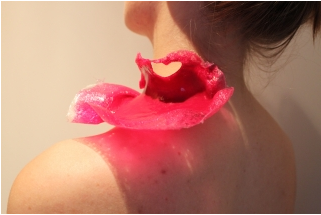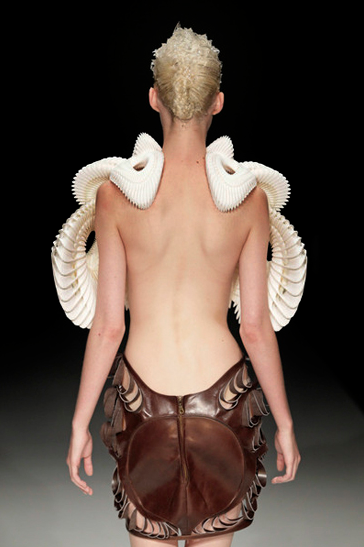RCA student Jungeun Lee has been experimenting a new technique for creating garment. By molding fibers around the body, she is able to create fabrics and garments with unexpected textures and shapes.
This project caught my interest for two reasons. The first thing is that the”wrapped garment” project calls into question the definition of a textile: here the technique uses non woven fibers, yet we can still call it a fabric. The second element is that the garment results from a modelling technique , meaning that its shape doesn’t come from the developpment of a pattern construction, but directly by applying the fibers on the body.
P.S: it seems that even shoes are made using the same process.
When digital environments create new fashion aesthetics: “Living Clothes” collection from Alice Ziccheddu
I am very delighted to see designers who are more and more interested into the digital fabrication of clothes.
Softwares created for clothes simulations already exist since quite a long time ( couldn’t say the exact year), but the method they imply reproduces exactly the one used in the physical world: first the design of patterns, then their application on a 3D body and textile simulation.
These softwares are designed to facililate fashion industries time production, but never to engender new aesthetics. This happens ( I think) because of the lack of collaboration between ingeneers and creatives.
But now fashion designers understand the huge potential of digital tools, especially 3D softwares, for the creation of new fashion paradigms.
This is the case with Alice Zicchedu, who, for her diploma collection, designed clothes first imagined in a digital 3D environment. In her website, she describes the collection as follows: The dress is virtually created around the body using a 3D software in order to reproduce textures and volumes belongings to the natural world, particularly to the mineral world. The mimesis of natural structures through digital processing leads to the creation of hybrid clothes. She also collaborated with argentinian 3D environment designer Carolina Travi who put some pictures of the creative process in her website:
The clothes are designed on 3Ds Max, a software that I know quite well. The bulk of the garments are not constructed as fluid materials but solids, which, in a way, facilitate their digital conception. I don’t think the bodies are animated, because it is extremely difficult to simulate a 3D object attached to the body, besides fluid mechanical properties.
However, what I would like to know is if the volumes are then flattened in order to allow the making of the patterns, or if the patterns are directly designed on the volumes… that would be interesting to know (even if I would pitch on the first assumption).
Once the garments are physically constructed, Ziccheddu incorporates sensors and microprocessors to make them interactive, sensing and reacting to their environment.
Vodpod videos no longer available.If there’s someone I can refer to when I have to talk about the integration of digital into fashion is definitely Iris van Herpen.
For her spring 2011 collection, she took further all the potential of digital design and presents breathtaking garments that range between post human age and poetry.
This collection is even more developped than the last one, yet still presenting the designer’s favourite themes.
Here we find extremely haptic and beautifully confusing pieces, with a perfect mix of technical materials ( usually not used in fashion), traditional textile manipulations, and digital fabrication techniques.
Talking about her work and the melting of art, fashion and product design in an interview by Dazed Digital van Herpen said: It’s a mix of everything. It’s important to work round the body, and my work is about fabric, shape and new techniques. I used a lot of fabrics commonly used in architecture –I like to bring new techniques into fashion, because otherwise I cannot breathe nor continue creating.
The result is a collection that evokes this kind of hybridation ( between technology, research on materials and fabric manipulations) by presenting uncertain garments:
Some organic-like elements, maybe lichens, melt into the dress and aggregate, sculpting the top of the garment. Everything seems to be manipulated by hands, yet the fabric is kind of unusual, silky and airy but rigid at the same time.
One other dress seems made of multiple random folds, reminding the softness of a light fabric, but made of a solid white material ( probably by using 3D printing technique).
The last one could remind of a fur from a distance, but seen closely, this “fur” is actually made of multiples layers positioned on their edge.
In this magical world of Iris van Herpen, high technology isn’t a synonym of rational or cold,but rather of a sweet illusion.
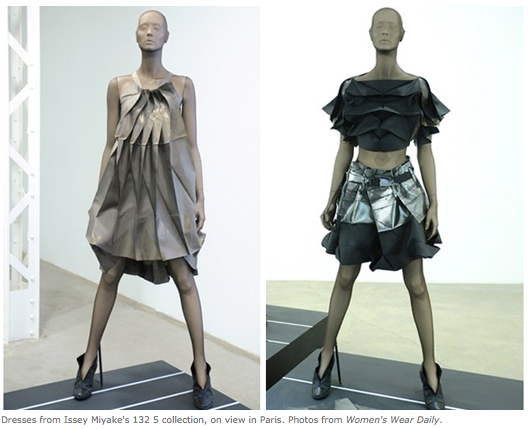 Why are the japanese so brillant? Do they have a particular gene that make them create wonderful, poetic and perfect shape? I still haven’t discovered their secret, but I can at least show you this 132.5 collection by Issey Miyake.
Why are the japanese so brillant? Do they have a particular gene that make them create wonderful, poetic and perfect shape? I still haven’t discovered their secret, but I can at least show you this 132.5 collection by Issey Miyake.
These pleated garments take shape originally from a plane. No cut, neither sewing but just a subtle pre- established folding that allows a single piece of textile (from recycled PET polyester by the way) to become a dress, a shirt or jacket.
This project has seen the light thanks to his collaboration with computer scientist Jun Mitani, who created a software that enables him to create 3D forms from a 2D panel.
The name of this collection “132.5 Issey Miyake” holds a secret meaning with these numbers: “1” signifies a single piece of fabric; “3” and “2” refer to the three-dimensional shape which can be flattened into a two-dimensional form; and “5” is a reference to the fifth dimension. The fifth dimension, according to Miyake, is the precise moment when the garment is worn on the body and comes to life “through the communication among people.”
source: fashioningtech and ecouterre
Molecular Food turns to be Molecular fashion: Edible Cloth By Emily Crane
When I first Herard about Emiliy’s work, it was on Philippa Wagner Blog some months ago.
I was already very interested in her work because I am in a “phase” of research where I work a lot about nature process inspired fashion design ( rather than just nature aesthetic appearance). Unfortunately, back then, apart from few pictures,I couldn’t get more informations about what exactly Emiliy is doing.
Just few days ago, Philippa Wagner posted additional pictures about her work. Then I also find a fabulous video about her work.
Emiliy is not the first to have worked with what we call “scientific couture”: Donna Franklin or Suzanne Lee and her Bio Couture from the CSM created garment made from living organism as cellulose bacteria or other fermentations. But what I found interesting in Emily’s edible clothing is that she took inspiration from molecular food and all its process, in order to create different textures. The result is also beautiful and very poetic and doesn’t inspire a little of disgust as it might be in Franklin or Lee.,But what it isn’t explained and I’m very curious about is if this textile took their shape independently or if Emily had to manipulate them afterwards… would be interesting to know even if I think that she created the form rather than letting the surface taking shape by itself.
Metamorphosis: The future of Home by Philips Design Probes
This video doesn’t directly talk about textile, but I found interesting the way of how the home of tomorrow is intended to be flexible. If you watch the video and see how the luminous structures evolve, absorb and move, there’s a clear analogy with the definition of a textile.
Digital Draping: how to apply pattern directly on a body
This past few years, textile and fashion industries slightly tend to consider that a fashion product should be a result of draping, pattern cutting and textile pattern designed simultaneously.
The consequences would be relevant from an industrial aspect, but also from a design point of view.
In this video, students from Kingston University Fashion MA show that textile and garment can melt in the digital world and maybe create in the future a new designer profile.
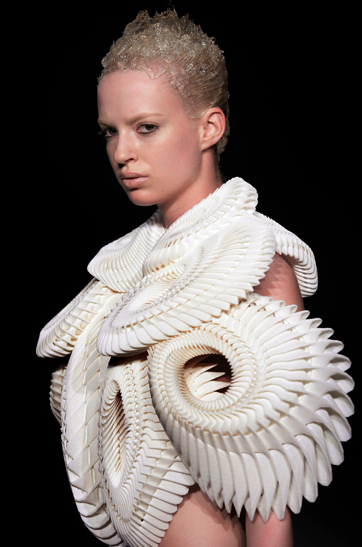
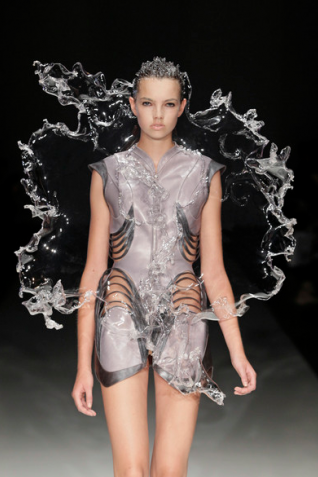
More and more I realize that avant-garde fashion comes often from Netherlands. From both a design and technological point of view, I have to admit that I am very often mesmerized by the creativity of this country.
This is the case of Iris van Herpen who made the first 3D printed fashion collection ever. This collection called “Crystallization” is the fruit of a collaboration with Daniel Widrig, designer and architect clearly interested in the so called “generated design”.
It appears normal to me the necessity of such a collaboration when we use digital technology in fashion. 3D print means that we don’t talk about a plane anymore but rather about a tridimensional object. Then this requires a design made in a 3D environment with computational skills.
These collaboration can be seen as a foretaste of what fashion design may be tomorrow: a kind of laboratory where textile and fashion designers work with architects , engineers and scientists.
I’m really looking forward!!!
For those who live in France and near Mulhouse, I’ll give a conference at Le Quai, the art school in Mulhouse, at 6pm.
I’ll will talk about the integration of innovative technologies in textile design and thus the following new esthetics and concepts of a textile.
I’ve seen they are doing beautiful things in the textile design department, so I’m really look forward to meet them and share my considerations!
“Touch_Me” project, 1st prototype
Here is a little video of my first prototype for the “Touch_Me” project. still need to improve some aspects, maybe a larger NiTi wire that would allow the mushrooms to move more drammatically, and of course, conductive threads which would make my project a trully soft circuit ,-)
Vodpod videos no longer available.
